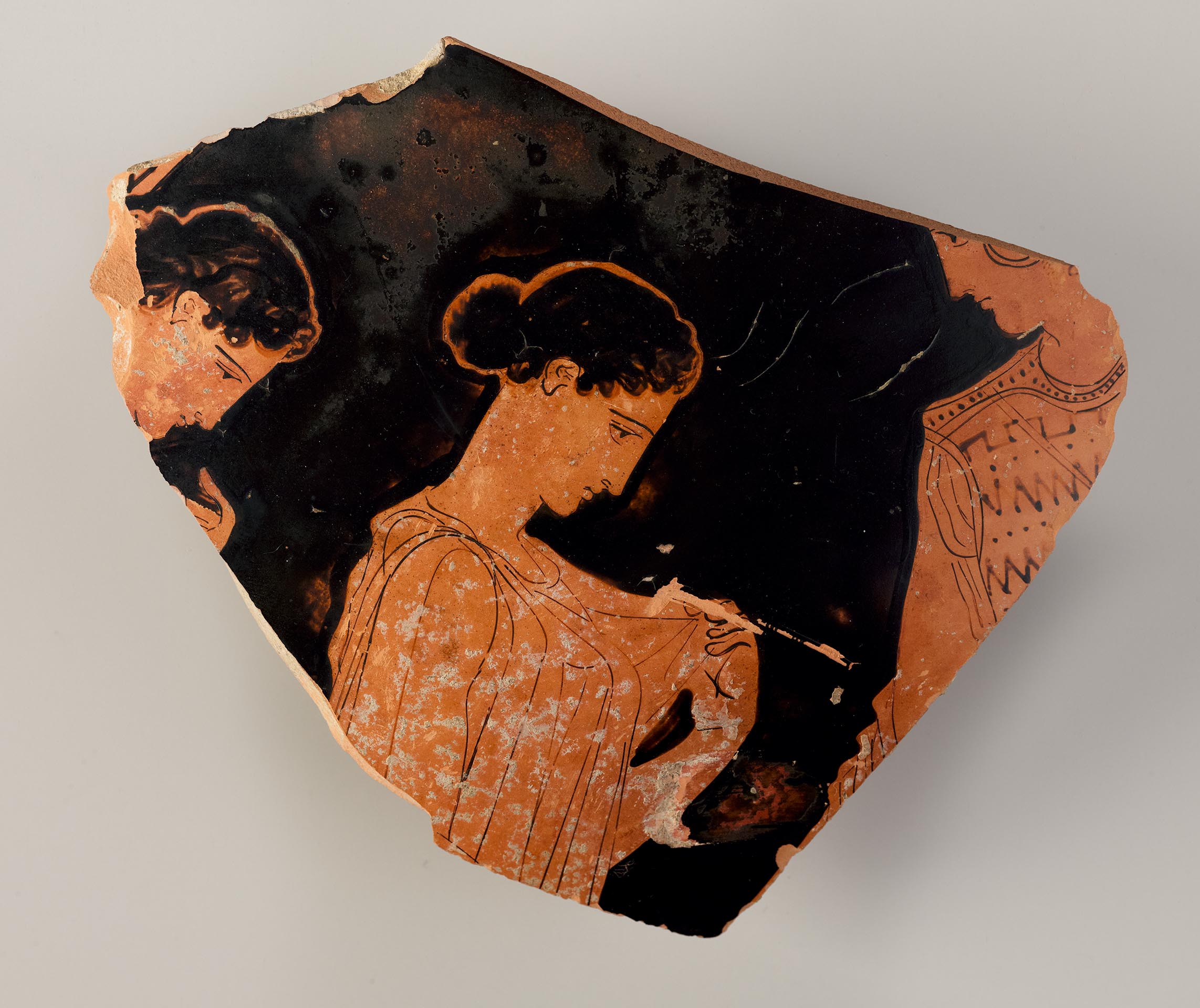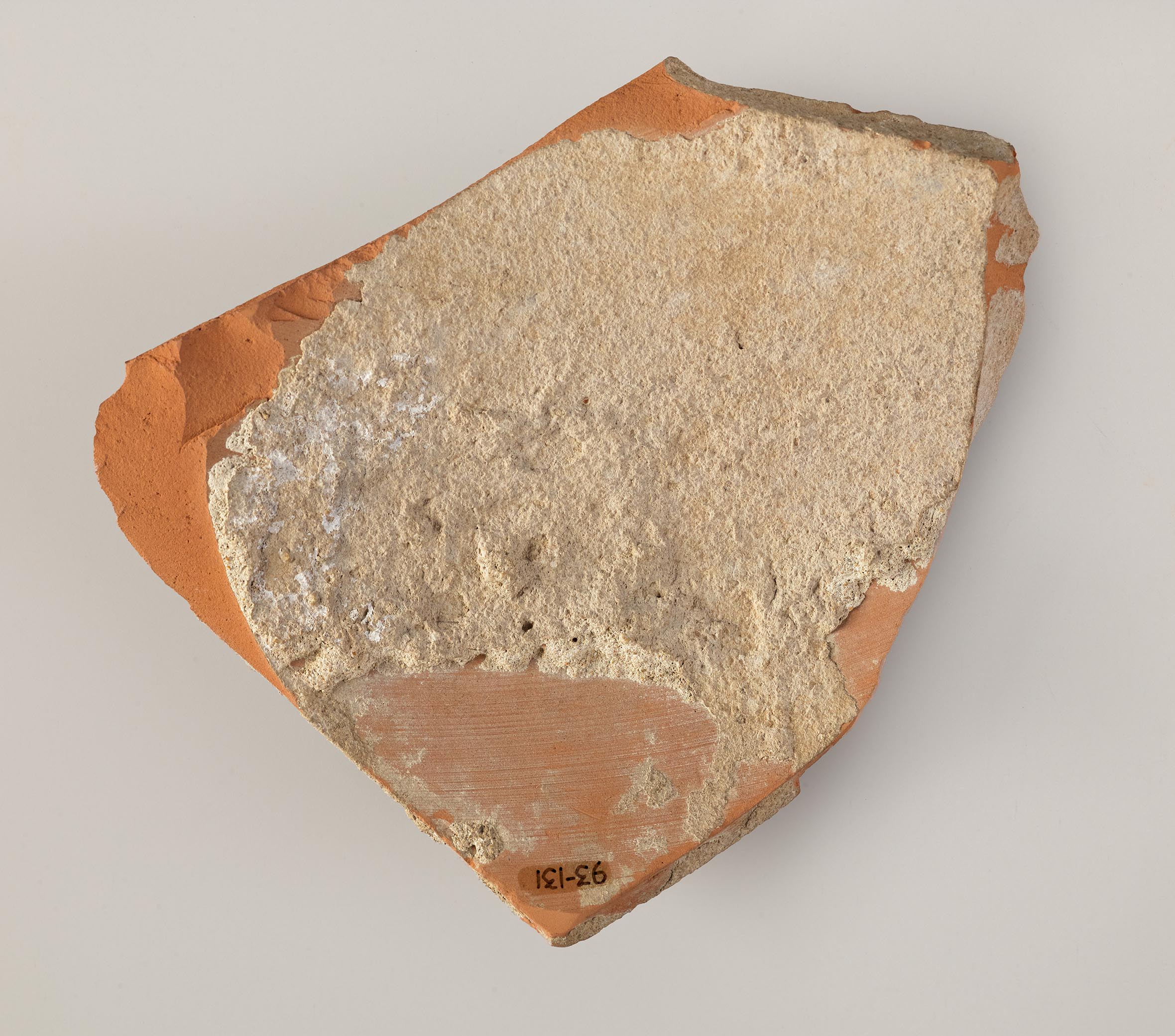Provenance
1993, sale, Atlantis Antiquities, Ltd. (New York, NY) to Princeton University.
Shape and Ornament
Single fragment from the body and lower neck of a large pot, most likely a pelike. Continuous profile between body and neck. Interior reserved. Reserved area to the left of figural scene and just above leftmost figure, framed by relief lines; it is unlikely to be part of an ornamental frame, considering the artist and the possible shapes. No other ornament preserved.

Subject
Departure. In the center, a woman stands in profile to the right, her lower body and right forearm lost. She wears a peplos, which she plucks up with her left hand. Her hair is tied back in a chignon bound by fillets in added white, now worn. She tilts her head down, averting her eyes from the gaze of the taller warrior at the right, who looks down at her. His face, right shoulder, right chest, and upper right arm are partially preserved. Although the top of his head is missing, two parallel, curved lines on his cheek most likely represent the cheek piece of a Chalcidian helmet, and a small point on his neck may be the edge of a neck guard. Extending beneath the cheek piece are sideburns drawn in dilute gloss. He wears a chitoniskos beneath a sleeveless ependytes decorated with horizontal motifs: battlements, rows of dots, zigzags. Part of a third garment is visible on his lower right arm, possibly a mantle. At the left, the head of second woman is preserved, in profile to the right. She also tilts her head downward and appears, judging from the position of her raised hand, to pluck up part of her garment, although this is entirely lost.
Attribution and Date
Attributed to the Kleophon Painter [J. Gaunt]. Circa 430 BCE.
Dimensions and Condition
16.5 × 12.2 cm; thickness: max. 1.1 cm; min. 0.7 cm. Broken on all sides. Scattered spots of incrustation, a gouge on the central woman’s forearm, and worn areas affecting in particular the woman at the left (the lower contour of her eye is lost). Black gloss misfired a rusty color at upper left. Interior almost entirely covered with a thick layer of incrustation.
Technical Features
Preliminary sketch. Relief contours for the faces of the figures and for the hand of the woman at left. Accessory color. White: fillets in the central woman’s hair. Dilute gloss: warrior’s sideburns.
Bibliography
Abbreviation: Princeton RecordRecord of the Princeton University Art Museum. (1942– ). 53 (1994): 81 [illus.], 83; M. Cook, A Brief History of the Human Race (New York, 2003), 233, fig. 21; Abbreviation: BAPDBeazley Archive Pottery Database. http://www.beazley.ox.ac.uk 28179.
Comparanda
For the Kleophon Painter, see Abbreviation: ARV2J. D. Beazley. Attic Red-Figure Vase-Painters. 2nd ed. Oxford, 1963 1062, 1143–51, 1684; Abbreviation: ParalipomenaJ. D. Beazley. Paralipomena: Additions to Attic Black-Figure Vase-Painters and to Attic Red-Figure Vase-Painters. Oxford, 1971 455–57; Abbreviation: BAdd2Carpenter, T. H., ed. 1989. Beazley Addenda: Additional References to ABV, ARV2, and Paralipomena. 2nd ed. Oxford: Published for the British Academy by Oxford University Press. 334–35; G. Gualandi, “Il Pittore di Kleophon,” Arte Antica e Moderna 5 (1962): 341–83; id., “Il Pittore di Kleophon rinvenute a Spina,” Arte Antica e Moderna 5 (1962): 227–60; E. De Miro, “Nuovi contribute sul Pittore di Kleophon,” Abbreviation: ArchCl Archeologia Classica 20 (1968): 238–48; K. F. Felten, Thanatos- und Kleophonmaler: Weissgrundige und rotfigurige Vasenmalerei der Parthenonzeit (Munich, 1971); C. Isler-Kerényi, “Chronologie und Synchronologie attischer Vasenmaler der Parthenonzeit,” Abbreviation: AntK-BHAntike Kunst: Beiheft 9 (1973): 23–32; M. Halm-Tisserant, “Le Peintre de Cleophon” (PhD diss., Université de Strasbourg, 1984); Abbreviation: Matheson, PolygnotosS. B. Matheson. Polygnotos and Vase Painting in Classical Athens. Madison, Wisc., 1995, 135–47. As Beazley noted, “The Kleophon Painter has a good many pictures of warriors about to leave home, and none of them is without a certain nobility”: L. D. Caskey and J. D. Beazley, Attic Vase Paintings in the Museum of Fine Arts, Boston, vol. III (Oxford, 1963), 76. Two stamnoi with scenes of departure provide very close parallels for the drawing of the women on Princeton’s fragment: Munich SH 2415 (Abbreviation: ARV2J. D. Beazley. Attic Red-Figure Vase-Painters. 2nd ed. Oxford, 1963 1143.2, 1684; Abbreviation: BAPDBeazley Archive Pottery Database. http://www.beazley.ox.ac.uk 215142); and St. Petersburg 1148 (Abbreviation: ARV2J. D. Beazley. Attic Red-Figure Vase-Painters. 2nd ed. Oxford, 1963 1143.3; Abbreviation: BAPDBeazley Archive Pottery Database. http://www.beazley.ox.ac.uk 215143). The women all have rectangular-shaped heads; eyes depicted as open triangles with a slightly convex upper lid and a fold directly above; a triangular pendant pupil toward the front of the eye; a relatively flat eyebrow extending to the bridge of the nose; a hooked nostril; detailed, supple lips drawn delicately with relief lines; and ears with two horizontal lines as part of the interior detailing. The fold lines of the peplos, especially those on the Munich stamnos, are also very similar: note the nearly identical lines caused by the plucking of the peplos, and the way in which the garment covers part of the woman’s right arm. For the warrior’s patterned, sleeveless tunic, compare the departing warrior on Boston 03.793 (Abbreviation: ARV2J. D. Beazley. Attic Red-Figure Vase-Painters. 2nd ed. Oxford, 1963 1145.37; Abbreviation: BAPDBeazley Archive Pottery Database. http://www.beazley.ox.ac.uk 215177). Isler-Kerényi (“Chronologie,” 29) has placed the Munich and St. Petersburg stamnoi in the latter part of the decade 440–430 BCE, at the height of the Kleophon Painter’s “Parthenonian” phase. As on these two vases, it is likely that a fourth figure stood behind the departing warrior on Princeton’s pelike, placing the warrior and the woman before him at the center of the composition. If the scene were a three-figure composition, we would expect the warrior to be in the center: cf. Boston 03.793 (supra); Munich SH 2394 (Abbreviation: ARV2J. D. Beazley. Attic Red-Figure Vase-Painters. 2nd ed. Oxford, 1963 1145.28; Abbreviation: BAPDBeazley Archive Pottery Database. http://www.beazley.ox.ac.uk 215168). Gualandi (“Il Pittore di Kleophon,” 341) places the three-figure compositions of departing warriors slightly later than those on the stamnoi in Munich and St. Petersburg, in the decade 430–420 BCE.
Not enough of the body and neck is preserved to determine definitively that the fragment comes from a large pelike rather than an amphora of Panathenaic shape. The former is more likely, as the shoulders of two red-figure Panathenaics attributed to the Kleophon Painter are more sharply sloping: Darmstadt 478 (Abbreviation: ARV2J. D. Beazley. Attic Red-Figure Vase-Painters. 2nd ed. Oxford, 1963 1146.48; Abbreviation: BAPDBeazley Archive Pottery Database. http://www.beazley.ox.ac.uk 215188); Quebec 66.231 (Abbreviation: Neils and Oakley, Coming of AgeNeils, J., and J. H. Oakley. 2003. Coming of Age in Ancient Greece: Images of Childhood from the Classical Past. Exhibition catalogue. Hood Museum of Art, Dartmouth College. Hanover, NH., 299–300, no. 114; Abbreviation: BAPDBeazley Archive Pottery Database. http://www.beazley.ox.ac.uk 50055). Pelikai were very popular within the Group of Polygnotos, and several have been attributed to the Kleophon Painter, some of them quite large: e.g., Boston 03.793 (supra); Munich SH 2361 (Abbreviation: ARV2J. D. Beazley. Attic Red-Figure Vase-Painters. 2nd ed. Oxford, 1963 1145.36; Abbreviation: BAPDBeazley Archive Pottery Database. http://www.beazley.ox.ac.uk 215176).
For general discussions of departure scenes in Attic vase-painting, see W. Wrede, “Kriegers Ausfahrt,” Abbreviation: AMMitteilungen des Deutschen Archäologischen Instituts, Athenische Abteilung 41 (1916): 221–374; H. A. Shapiro, “Comings and Goings: The Iconography of Departure and Arrival on Attic Vases,” Abbreviation: MètisMètis: Anthropologie des mondes grecs anciens 5 (1990): 113–26; A. B. Spiess, Der Kriegerabschied auf attischen Vasen der archaischen Zeit (Frankfurt, 1992), esp. 160–86; S. B. Matheson, “A Farewell with Arms: Departing Warriors on Athenian Vases,” in Periklean Athens and Its Legacy: Problems and Perspectives, eds. J. M. Barringer and J. M. Hurwit (Austin, TX, 2005), 23–35; id., “Beardless, Armed, and Barefoot: Ephebes, Warriors, and Ritual on Athenian Vases,” in Abbreviation: Archaeology of RepresentationsAn Archaeology of Representations: Ancient Greek Vase-Painting and Contemporary Methodologies. Edited by D. Yatromanolakis. Athens, 2009, 374–413. For the suggestion that departure scenes could in fact represent arrivals, see T. McNiven, “Gestures in Attic Vase-Painting: Use and Meaning, 550–450 BC” (PhD diss., University of Michigan, 1982), 37–38; F. Lissarrague, “The World of the Warrior,” in Abbreviation: City of ImagesA City of Images: Iconography and Society in Ancient Greece. Edited by C. Bérard et. al. and translated from French by D. Lyons. Princeton, 1989, 44–45. See also, with an emphasis on the lack of clear signs indicating departure or arrival, M. Gaifman, The Art of Libation in Classical Athens (New Haven, CT, 2018), 56–61, 74–85. Judging from the lack of greeting gestures, such as raised hands, and the solemn nature of the scene, Princeton’s fragment should most likely be viewed as a departure rather than an arrival. Compared with contemporary artists, such as the Achilles Painter and his group, the Group of Polygnotos was extremely fond of departure scenes; see E. G. Pemberton, “The Name Vase of the Peleus Painter,” Abbreviation: JWaltThe Journal of the Walters Art Gallery 36 (1977): 62–72; Abbreviation: Matheson, PolygnotosS. B. Matheson. Polygnotos and Vase Painting in Classical Athens. Madison, Wisc., 1995, 269–76.
Matheson (“A Farewell with Arms”) divides scenes of departure into two categories, the departure of soldiers for an actual military campaign and, following the suggestion of Vernant, the departure of ephebes for a stage of their military training and service: J. P. Vernant, Mythe et société en Grèce ancienne (Paris, 1974), 37–38. If we accept this division, the beardless youth on Princeton’s fragment perhaps falls in the latter category. That he wears only a tunic above his chitoniskos, and not a cuirass, may also suggest that he is an ephebe, though not all bearded warriors wear the full panoply and not all hoplites are bearded. For a beardless hoplite wearing the full panoply, cf. a neck amphora by the Kleophon Painter in a Munich private collection (Abbreviation: ARV2J. D. Beazley. Attic Red-Figure Vase-Painters. 2nd ed. Oxford, 1963 1146.44; Abbreviation: BAPDBeazley Archive Pottery Database. http://www.beazley.ox.ac.uk 215184). The patterned garment worn by the departing figure on Princeton’s fragment and on the pelike in Boston (supra) may be connected with the ceremonial tunic called the ependytes, worn during the ritual bestowal of arms to an ephebe: Matheson, “A Farewell with Arms,” 32. If this is the case, the woman immediately before him should be identified as his mother, with the second woman at the left perhaps being his sister. For a general discussion of the ependytes, see M. C. Miller, “The Ependytes in Classical Athens,” Abbreviation: HesperiaHesperia: The Journal of the American School of Classical Studies at Athens 58 (1989): 313–29.
Both categories of departure, as defined by Matheson, predominantly depict scenes of libation. It is unclear whether that is the case on Princeton’s fragment, as no vessels are preserved. Judging by the similarity of pose between the central woman and those on the stamnoi in Munich and St. Petersburg, it is possible that the woman carried an oinochoe in her lowered hand. Perhaps the warrior then held a phiale in his lowered right hand, although the phiale tends to be raised in scenes of libation, as on the Kleophon Painter’s stamnoi in Munich and St. Petersburg. Both types of scenes are likely domestic, although elements of a setting are only occasionally introduced, such as a column, seat, or door, all of which would signify a house or courtyard. For a recent discussion of departure scenes with a focus on the act of libation and the importance of the libation for affirming close familial ties, see Gaifman, Art of Libation, 56–62.
The gesture of the woman on Princeton’s fragment and on the many departure scenes painted by the Kleophon Painter and the Group of Polygnotos has traditionally been designated as anakalypsis, an act of unveiling: see C. M. Galt, “Veiled ladies,” Abbreviation: AJAAmerican Journal of Archaeology 35 (1931): 373–93; D. L. Cairns, “Veiling, aἰδώς, and a Red-figure Amphora by Phintias,” Abbreviation: JHSJournal of Hellenic Studies 116 (1996): 152–58; R. Gondek, “Lifting the Veil: Identity and Dress of Brides on Athenian Vases,” in Identity Crisis: Archaeological Perspectives on Social Identity, Proceedings of the 42nd (2010) Annual Chacmool Conference, University of Calgary, eds. L. Amundsen-Meyer, N. Engel, and S. Pickering (Calgary, 2011), 74–85. Llewellyn-Jones has argued that the gesture, as opposed to the fully enveloped head veil, allowed the vase-painter to allude to the female figure’s aidos without blocking the view of her physical beauty: L. Llewellyn-Jones, Aphrodite’s Tortoise: The Veiled Woman of Ancient Greece (Swansea, 2003), 85–120. With reference to the Kleophon Painter’s stamnos in Munich, Moignard has argued that the veiling gesture of the women within scenes of departure may foreshadow mourning at the death of the soldier: E. Moignard, Master of Attic Black-Figure Painting: The Art and Legacy of Exekias (London, 2015), 43.

